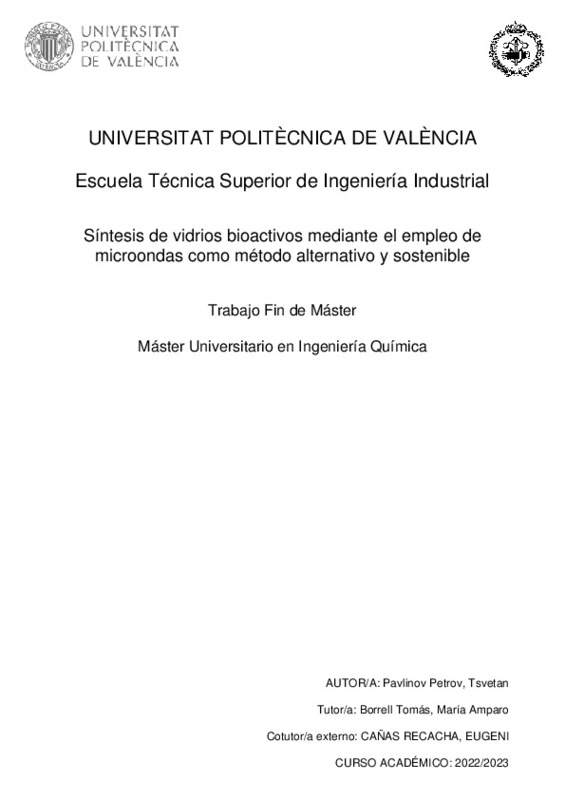|
Resumen:
|
[ES] Recientemente, los vidrios bioactivos se han postulado como posibles sustitutos de la hidroxiapatita para aplicaciones biomédicas. Aunque ambos materiales presentan propiedades mecánicas similares, estos vidrios exhiben ...[+]
[ES] Recientemente, los vidrios bioactivos se han postulado como posibles sustitutos de la hidroxiapatita para aplicaciones biomédicas. Aunque ambos materiales presentan propiedades mecánicas similares, estos vidrios exhiben mayor bioactividad (son osteoinductores y osteoconductores). La vía de síntesis tradicional de estos materiales es el conocido método de fusión y enfriamiento brusco, aunque durante las últimas décadas ha surgido una ruta alternativa, el método sol-gel. Este último método presenta múltiples ventajas, como el perfecto control de la composición y su fácil modificación, obtención de diferentes geometrías, así como bajas temperaturas de procesamiento. Sin embargo, el método sol-gel requiere largos tiempos de procesamiento del material (mínimo 1 semana).
El empleo de la radiación de microondas puede suponer una mejora sustancial del proceso de síntesis de vidrios bioactivos sin comprometer la calidad de estos. Mediante esta tecnología se produce un calentamiento rápido y uniforme, supone un gran ahorro energético, conlleva un mayor rendimiento y menor tiempo de preparación junto con un menor coste de procesado. Actualmente el uso de microondas está bastante extendido en la síntesis de diferentes materiales cerámicos avanzados (alúmina, circona, titania, aluminato de magnesio, hidroxiapatita o fosfatos cálcicos). No obstante, apenas hay estudios sobre la obtención de vidrios bioactivos haciendo uso de las microondas.
Por ello, el objetivo principal de este trabajo es estudiar la viabilidad del empleo de microondas en la síntesis de vidrios bioactivos, más concretamente el vidrio bioactivo 58S (58% SiO2, 33% CaO y 9% P2O5, todo en % en peso). A modo comparativo se sintetizará este vidrio mediante el método tradicional de sol-gel, y los vidrios resultantes de ambas rutas de síntesis se caracterizarán desde un punto de vista microestructural y biológico.
[-]
[EN] Recently, the bioactive glass has been postulate as possible substitution of the
hydroxyapatite for biomedical application. Although the properties of both materials are similar,
the bioactivity (osteoinductor and ...[+]
[EN] Recently, the bioactive glass has been postulate as possible substitution of the
hydroxyapatite for biomedical application. Although the properties of both materials are similar,
the bioactivity (osteoinductor and osteoconductor) of these glasses is higher. The traditional
method of synthesis is the melt-quench route despite of the discovery of the sol-gel method in the
last decades. This method present multiple advantages as perfect composition control and his easy
modification, obtain different geometries and lower processing temperature. Although these
advantages, this method require large processing time (minimum 1 week).
The use of microwave radiation can suppose a substantial upgrade of bioactive glass
synthesis process without involve the quality of them. The use of this technology produce a quick
and uniform heating, making a large energetic save, a larger performance and lower preparation
time with lower processing time. Nowadays, the use of microwave is widespread in the synthesis
of different advanced ceramic materials (alumina, zirconia, titania, magnesium aluminate,
hydroxyapatite or calcium phosphate). However, there are barely studies about obtaining bioactive
glasses using a microwave.
Therefore, the main objective of this study is to determine the viability of the use of
microwave in the synthesis of bioactive glasses, more specifically at the 58S bioactive glass (58%
SiO2, 33% CaO y 9% P2O5, all in % in weight). In a comparative way, this glass will be synthesized by
the traditional sol-gel route, and the resultant glasses of both synthesis routes will be characterized
from microstructural and biological point of view.
[-]
|







